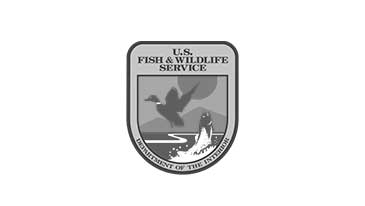Snake Removal & Identification
Do you have a snake problem in or around your property? Contact us today to schedule a snake removal service!
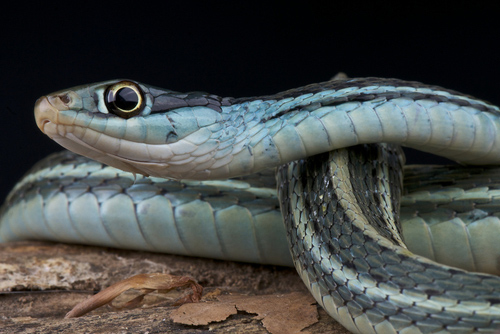
Snake Identification and Characteristics: What are Snakes?
Snakes are long, legless reptiles that move by slithering along the ground. Their appearance varies depending on their species; their colors can be green, red, yellow, blue, black, or brown. A few of the most common pest snakes are garter, ribbon, and corn snakes.
Keep reading to learn more about the most common pest snake varieties and how Varment Guard can help keep them away from your property.
What Kind of Pest Snakes are There?
There are more than 3,400 species of snakes in the world. However, you don’t have to worry about most of those being a problem in your yard. However, it can still seem tough to know how to identify a snake in Ohio, Minnesota, or somewhere else in the Varment Guard service area.
To help you identify the snakes in your yard, we compiled some information on a few of the most common pest snakes near you:
Garter and Ribbon Snakes
These snakes have a brown or black upper body background with 3 light olive green, yellow, red, or orange stripes and alternating black spots on stripes. Their underside is light green, white, or yellow.
The common garter snake is commonly found in yards by fields, woods and water in Ohio.
- Adult body length: 22 to 35 inches
- Eggs laid or young born alive: 3 to 96 young born alive per year
- Birthing season: June through September
- Activity period: Daytime
- Behavior / disposition: Mild to aggressive
- Primary diet: Earthworms, leeches, insects, fish, frogs, mice
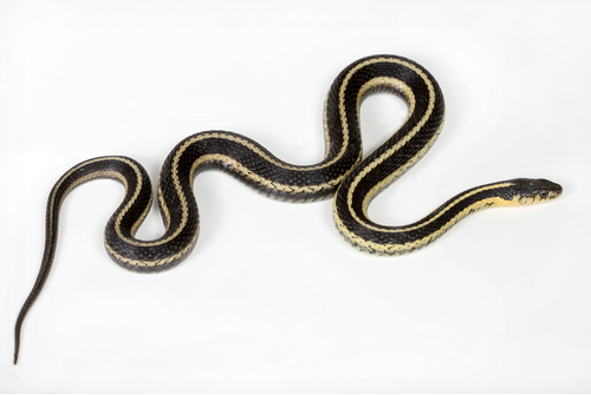
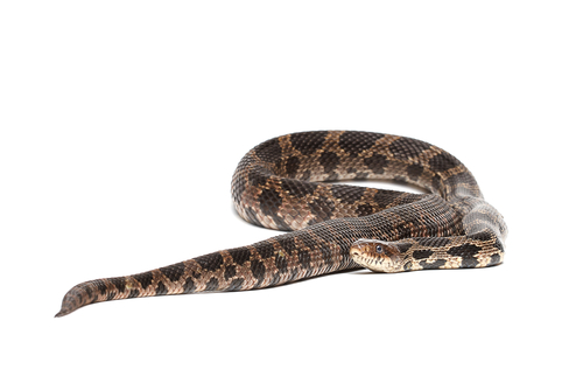
Corn, Rat, and Fox Snakes
The upper body background of these snakes are yellow, light brown, reddish-brown, gray, or black with red, brown, or black saddle-blotches or stripes. Their underside is white to yellow with dark patterning.
Black rat snakes are common in Ohio by woods, fields, and water.
- Adult body length: 48 to 72 inches
- Eggs laid or young born alive: 3 to 44 eggs laid June – August
- Birthing season: Hatchlings August through October
- Activity period: Night (pre-sunset to post-dawn)
- Behavior / disposition: Threatening; will bite; moderate in captivity
- Primary diet: Frogs, lizards, birds, bird eggs, small rodents, other small mammals
Water Snakes
With a brown, gray, or black upper body background, some water snake species also have alternating dorsal and side blotches. Their underside can be anywhere from white to yellow with variable markings.
The northern water snake is occasionally encountered near Lake Erie and other smaller lakes; it can be easily confused for the cottonmouth.
- Adult body length: 48 to 69 inches
- Eggs laid or young born alive: 7 to 58 young born alive per year
- Birthing season: June through October
- Activity period: Anytime (temperature-dependent)
- Behavior / disposition: Aggressive; will bite
- Primary diet: Fish, frogs, tadpoles, newts, mudpuppies, salamanders, crawfish and crabs
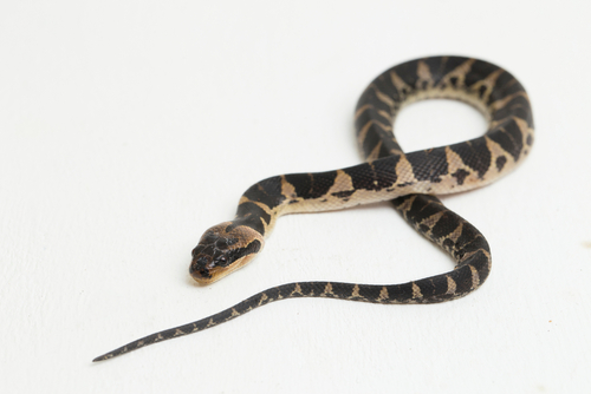
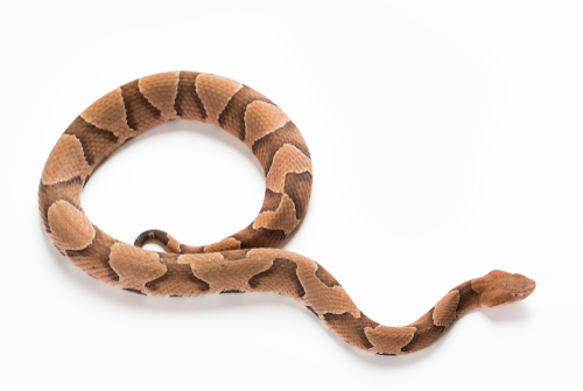
Copperhead
These snakes have a coppery-brown, reddish, or pink head, a light brown or pink body, and dark-outlined hourglass-shaped crossbands. Their underside is white with dark blotches.
Copperheads are found sparingly on rocky banks of rivers and creeks, especially in Ohio. When they’re nearby, a cucumber-like odor can be detected.
- Adult body length: 36+ inches
- Eggs laid or young born alive: 2 to 17 young born alive
- Birthing season: August through October
- Activity period: Daytime
- Behavior / disposition: Moderate to aggressive
- Primary diet: Amphibians, reptiles, small birds, rodents
Massasauga Rattlesnake
These snakes have a brown to black background color with dark blotches along the back. Their underside is dark and heavily blotched.
Massasauga rattlesnakes are rare in Ohio and prefer edges of swamps, marshes, streams, ponds, meadows, fields, and fencerows.
- Adult body length: 24 to 30 inches
- Eggs laid or young born alive: 2 to 32 young born alive per year
- Birthing season: July through September
- Activity period: Daytime
- Behavior / disposition: Moderate
- Primary diet: Insects, frogs, lizards, small birds, mice
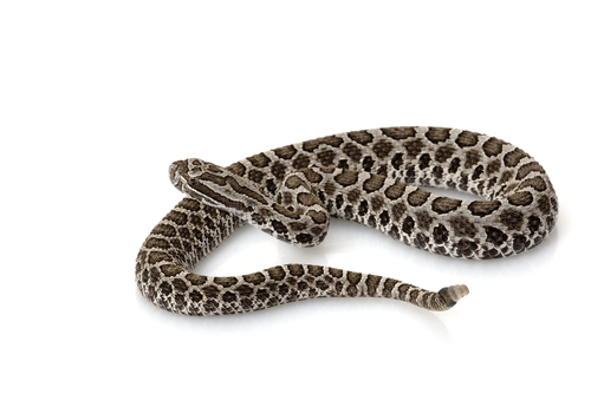

Need Help with Michigan, Minnesota, or Ohio Snake Identification?
The snakes pictured above are common snakes in Ohio and the surrounding areas. However, that doesn’t mean these are the only snakes in the Midwest and beyond!
If you’re not seeing the snake that’s been slithering around your property listed above, it’s time to bring in the experts! Use Varment Guard’s wildlife identification form to find out exactly what scaly creature has been spending time on your property.

Professional Snake Removal & Prevention
To remove and prevent snakes, Varment Guard offers:To remove and prevent snakes, Varment Guard offers:
1. Snake Exclusion
In order to prevent snakes from entering your space, we caulk and seal structural or foundation gaps and screen crawl space vents.
2. Snake Trapping
We can capture snakes that have entered under dwellings, garages, warehouses or along buildings by placing sticky traps. Scent attractant can be applied to the traps. Water-style traps are used in circumstances where water snakes are present.
Once the snakes are caught, they are humanely removed from the sticky trap with the use of vegetable oil. They are then released back into a suitable habitat far away from where they were captured.
Once the snake trapping program is finished, we can place snake repellent around the perimeter of where snake activity was present.
3. Snake Stick and Hand-Capture
Varment Guard technicians are properly trained to handle and remove snakes by hand. This occurs if the snake is found inside the structure and can be reached. Snakes can be removed by hand or with a snake stick.
Keep Slithering Serpents Away from Your Space with Varment Guard
From garter snake removal in Ohio to water snake prevention in Michigan, Varment can do it all quickly, efficiently, and humanely. Ready to get started? Contact Varment Guard’s expert snake technicians today!

We can get rid your of snake problems safely and efficiently!
Frequently Asked Questions:
When Do Snakes Wake Up?
Snakes begin emerging from brumation as soon as the air temperature rises enough to heat them up. In general, most snakes “awaken” from brumation permanently starting in early spring, around the same time their prey becomes active. Snakes also tend to come out after periods of rain. Learn more!
How Do I Keep Snakes Away?
Keeping your lawn short, removing debris, fixing any moisture areas from hose drippage, and patching up any cracks are a few ways to keep snakes away from your yard. Additionally, checking for moisture in your basement is crucial to keeping snakes from inhabiting your home. Read more!
Where Do Snakes Go in the Fall?
Snakes don’t actually enter hibernation, but they do enter a hibernation-like state of suspended activity called “brumation.” As cold-blooded reptiles, snakes rely on brumation to maintain their internal body temperature during cold weather. Unfortunately for snakes, brumation can maintain temperatures and conserve energy, but it can’t actually keep them warm. Learn more!
What Do I Do if I Get a Snake Bite?
You should always take snake bites seriously. If you’ve been bitten by a snake, seek medical attention immediately. While you’re waiting for professional help, clean the wound but don’t flush it with water. Do not attempt to capture the snake, but remember what it looked like. Identifying the snake will help professionals treat you more effectively. Read more!
MORE ABOUT SNAKES / HEALTH RISKS
Almost any snake that finds its way indoors or is discovered in a home garden may, unfortunately, invoke mild hysteria in persons who have no appreciation for snakes. Beyond the connection between snakes (serpents) and Satan (evil) described in the book of Genesis, much fear and disdain for snakes stems from the possibility of encountering one or more of the several venomous or aggressive species that are native to this continent; although only 16% of the species in the United States can be considered dangerous.
Furthermore, the general public has difficulty in identifying snakes correctly. Two families of snakes are responsible for most of the fear expressed by the general public. Rattlesnakes, water moccasins (cottonmouths) and copperheads are the North American representative pit vipers (family Crotalidae, a.k.a. Viperidae),which possess heat sensors located in visible loreal (facial) pits between the nostril and eye on each side of the head. These sense organs mainly enable them to seek out and capture warm-bodied prey, even in darkness. It can be dangerous to pick up a recently killed rattlesnake or the head of a decapitated rattlesnake, for example, because the warmth of the hand may cause the snake’s mouth to open reflexively, with the extendable, hypodermic-like fangs ready to inject venom, if the hand is in position to be bitten. The eastern coral snake is the sole representative of the family Elaphidae – the only other family of venomous snakes found in the U.S. Coral snakes are not found in Ohio, except in captivity.
Practically all other snakes commonly seen in the United States belong to the largest family, Colubridae. This group includes bull snakes, various racers, gopher snakes, king snakes, garter, ribbon, green and water snakes, coach whip snake, corn, rat and fox snakes, to name some of the more common species. Nevertheless, few people are willing to tolerate any snakes on their property, especially if children frequently play in the area. In addition, some controls may be justified during the nesting season at bird sanctuaries, in duck-nesting marshes, and at fish hatcheries to prevent loss of fry.

